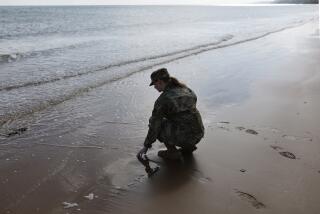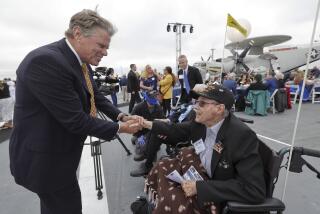50 Years of Memories : Seabees--Present and Past--Celebrate Anniversary at Base
- Share via
Watching rows of Navy Seabees march by in their dress whites, former Seabee Bill Zuckert was reminded of the three years he served as a Seabee in the South Pacific during World War II.
“This brings back good memories of when I was young and wearing whites like these guys,” the 76-year-old actor from Toluca Lake said Saturday at the 50th anniversary celebration of the Seabees.
“Funny thing is, I couldn’t wait to get out of the uniform back then,” said Zuckert, who was visiting the naval Construction Battalion Center in Port Hueneme for the first time since leaving the service in 1946.
Zuckert was one of the hundreds of former Seabees among the crowds Saturday to celebrate a half-century of Navy Construction Battalions, known as Seabees from the group’s initials of C B. Their job is to build bridges, barracks, runways and bunkers--all under enemy fire.
After the military parade in the morning, the Seabees, their families and area residents wandered about the carnival midway and examined displays of the Seabees’ tools and weapons. A stream of visitors also clambered aboard the Navy frigate Fanning anchored in the port for the occasion.
Snatches of military music drifted with the breeze above the crowded parade field as a service band played ahead of the featured performance by country and Western singer Crystal Gayle.
The event also marked the 50th anniversary of the Port Hueneme base, and some who attended the festivities Saturday were surprised by the changes at the base since they had left the service.
“The base has changed a lot since I left in 1978,” said Archie Johnson, 56, of Ft. Wayne, Ind. “There were still a lot of Quonset huts when I left; now there are a lot of new structures made of concrete.”
Seated next to Johnson, Harvey Mittleman of Brooklyn, N.Y., was ready to skewer the makeshift buildings that sprung up around military bases across the country during World War II.
“It’s a shame they destroyed the Quonset hut,” Mittleman said with a deadpan expression. “I have a lot of memories of the Quonset huts--freezing my butt off in them.”
Mittleman, a demolition specialist during World War II, said he felt a kinship with the present-day Seabees.
“Being here brings back a lot of memories--some good and a lot bad. You remember the fatalities and being scared all the time of the unknown,” he said, recalling his perilous job of locating land mines in Okinawa with a metal detector and then blowing them up with a stick of dynamite. “You got a lot older real quick.”
Johnson, who served as a construction electrician with the 11th Mobile Construction Battalion in Vietnam, said he remembers the shelling and sniper fire the Seabees experienced at Da Nang in 1966.
“We’d hear the whistling sound and knew we had incoming,” Johnson said of his Vietnam duty. “You would run out of your hut in your skivvies and hit the dirt.”
He was sent there to build mess halls, a Marine camp and covered storage buildings--the dirty and sometimes hazardous work that Seabees are prepared to do. Like most former Seabees, he recalled the successes of scavenging materials to complete a job. To build a latrine, for instance, Johnson said he fashioned valve floats from 40-millimeter artillery shells and scrounged mercury bottles from air conditioners to use as pump motors.
“We had no parts to fix it otherwise,” he explained.
While the retired Seabees reminisced, throngs of boys and girls visited the displays of weaponry that stood next to the Seabees’ heavy equipment.
As John Low, 15, of Westlake Village lifted an M-203 grenade launcher to his shoulder, Heavy Equipment Operator 1st Class Doug Barbian explained how dangerous the weapon was to operate.
The weapon’s exhaust, he said, “will kill anything within 15 meters behind you. And it can seriously injure people up to 100 feet away.”
Also on display were exhibits demonstrating the construction and emergency services the Seabees perform.
At one booth, surveyors’ transits stood next to cylinders used to test the strength of fresh concrete. A nearby booth had an exhibit from the Disaster Recovery School, where a technician showed Steven Edwards, 15, of Camarillo how to listen through headphones for evidence of radiation picked up by a detector.
Senior Chief Engineer Merv Nenstiel took a break from the celebration to have his blood pressure measured by a volunteer at a community service booth.
Nenstiel, a 24-year veteran Seabee decorated with two rows of service medals, said he attended the anniversary event to see some of the men he served with during the 1960s. He said he found very few.
“After 24 years, it’s time to go,” said Nenstiel, who plans to retire this fall. “That’s a long time to spend in this type of environment.”
More to Read
Sign up for Essential California
The most important California stories and recommendations in your inbox every morning.
You may occasionally receive promotional content from the Los Angeles Times.










